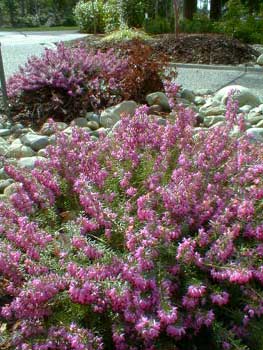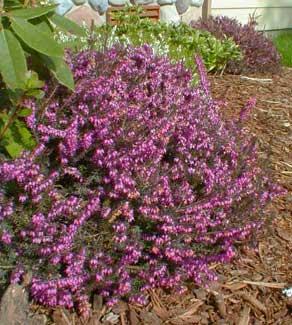
Pink Winter Heath
"I love your hills, & I love your dales,
And I love your flocks a-bleating;
But O, on the heather to lie together,
With both our hearts a-beating!"
-John Keats
(1795-1821)
(1795-1821)
The two most commonly gardened Winter Heath cultivars are 'Mediterranean White' & 'Mediterranean Pink,' the latter about halfway between pink & purple. There are many other varieties, but these two basic hardies set the standard of reliability of winter impact.
Erica darleyensis, occasionally listed as E. hybrida, originated as a spontaneous cross of the bellheathers E. carnea & E. erigena. Its name darleyensis refers to Darley Dale, a place in Derbyshire, England, where Winter Heath was first grown at the end of the Victorian era in the James Smith Nursery where the first hybrid seedlings appeared.
 'Mediterranean Pink' is probably the same as the original 'Darley Dale' which was first marketed in 1900 at James Smith Nursery.
'Mediterranean Pink' is probably the same as the original 'Darley Dale' which was first marketed in 1900 at James Smith Nursery.The foliage can be ruined if inside the dripline of a tree that sheds onto the winter-heath's tiny foliage, as it positively hates anything covering or stuck in its dense slim branches. Nor will it bloom if it is in the shade. The woodland gardens at Paghat's & Granny Artemis's house simply do not suit winter heaths, but some of the open sunny gardens in a friend's are perfect for them, as these photos reveal.
Though its water needs are not high, if conditions are too droughty, this will keep the plant stunted & cause a lot of leaf browning & blackening, resulting in a grubby looking shrub in or out of flower. Ruined-looking specimens can be pruned back & will slowly recover if conditions improve for it, but sheering only makes it punier if conditions remain unfavorable.
By contrast, a specimen that likes its location will form a perfect mound of year-round evergreen leaves. Ideally it is in full sun in an open garden or rock garden, uncrowded, in humusy soil with moderate watering but very well-draining soil never too damp. In happiest circumstance it can go a long while without much pruning & still hold a formal shape, or require only a light post-bloom sheering.
It is sometimes slow-growing but eventually becomes a foot tall & up to a two-foot wide shrub. In any year that it looks its best it should not be fertilized. Every second or third year it can be given a low-nitrogen slow-release fertilizer; rhododendron fertilizer meets the requirement, or even nothing more than a spring mulching with well composted manure.
Its lavender-pink flowers are in full sway by December, often sooner, & last very handsomely until the start of March or even into April. They are practically everblooming in winter & one of the most important shrubs for insuring flowers in Northwest winter gardens.